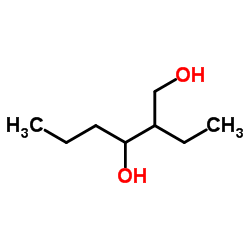Octyl 4-methoxycinnamate

Octyl 4-methoxycinnamate structure
|
Common Name | Octyl 4-methoxycinnamate | ||
|---|---|---|---|---|
| CAS Number | 5466-77-3 | Molecular Weight | 290.397 | |
| Density | 1.0±0.1 g/cm3 | Boiling Point | 405.3±20.0 °C at 760 mmHg | |
| Molecular Formula | C18H26O3 | Melting Point | N/A | |
| MSDS | Chinese USA | Flash Point | 171.6±16.4 °C | |
Use of Octyl 4-methoxycinnamateOctinoxate is an organic compound that is an ingredient in some sunscreens and lip balms, primarily used is in sunscreens and other cosmetics to absorb UV-B rays from the sun, protecting the skin from damage. It is also used to reduce the appearance of scars. |
| Name | octyl methoxycinnamate |
|---|---|
| Synonym | More Synonyms |
| Description | Octinoxate is an organic compound that is an ingredient in some sunscreens and lip balms, primarily used is in sunscreens and other cosmetics to absorb UV-B rays from the sun, protecting the skin from damage. It is also used to reduce the appearance of scars. |
|---|---|
| Related Catalog |
| Density | 1.0±0.1 g/cm3 |
|---|---|
| Boiling Point | 405.3±20.0 °C at 760 mmHg |
| Molecular Formula | C18H26O3 |
| Molecular Weight | 290.397 |
| Flash Point | 171.6±16.4 °C |
| Exact Mass | 290.188202 |
| PSA | 35.53000 |
| LogP | 5.66 |
| Vapour Pressure | 0.0±0.9 mmHg at 25°C |
| Index of Refraction | 1.515 |
| Storage condition | 2-8°C |
| Stability | Stable. Incompatible with strong oxidizing agents. |
| Water Solubility | <0.1 g/100 mL at 27 ºC |
| Precursor 10 | |
|---|---|
| DownStream 2 | |
| HS Code | 2918990090 |
|---|---|
| Summary | 2918990090. other carboxylic acids with additional oxygen function and their anhydrides, halides, peroxides and peroxyacids; their halogenated, sulphonated, nitrated or nitrosated derivatives. VAT:17.0%. Tax rebate rate:13.0%. . MFN tariff:6.5%. General tariff:30.0% |
|
Translating clinical findings into knowledge in drug safety evaluation--drug induced liver injury prediction system (DILIps).
J. Sci. Ind. Res. 65(10) , 808, (2006) Drug-induced liver injury (DILI) is a significant concern in drug development due to the poor concordance between preclinical and clinical findings of liver toxicity. We hypothesized that the DILI typ... |
|
|
Developing structure-activity relationships for the prediction of hepatotoxicity.
Chem. Res. Toxicol. 23 , 1215-22, (2010) Drug-induced liver injury is a major issue of concern and has led to the withdrawal of a significant number of marketed drugs. An understanding of structure-activity relationships (SARs) of chemicals ... |
|
|
A predictive ligand-based Bayesian model for human drug-induced liver injury.
Drug Metab. Dispos. 38 , 2302-8, (2010) Drug-induced liver injury (DILI) is one of the most important reasons for drug development failure at both preapproval and postapproval stages. There has been increased interest in developing predicti... |
| Escalol 557 |
| Eusolex 2292 |
| Neo Heliopan AV |
| 2-ethylhexyl (E)-3-(4-methoxyphenyl)prop-2-enoate |
| 3-(4-METHOXYPHENYL)-2-PROPENOIC ACID 2-ETHYLHEXYL ESTER |
| 2-Ethylhexyl (2E)-3-(4-methoxyphenyl)acrylate |
| octinoxate |
| 2-Ethylhexyl trans-4-methoxycinnamate |
| 2-Propenoic acid, 3- (4-methoxyphenyl)-, 2-ethylhexyl ester |
| 2-Propenoic acid, 3-(4-methoxyphenyl)-, 2-ethylhexyl ester, (2E)- |
| Octyl p-Methoxycinnamate |
| Uvinul MC 80 |
| octyl methoxycinnamate |
| Octyl 4-methoxycinnamate |
| MFCD00072582 |
| PARSOL MCX |
| Uvinul 3088 |
| 2-ethylhexyl (2E)-3-(4-methoxyphenyl)prop-2-enoate |
| 2-Ethylhexyl (2E)-3-(4-methoxyphenyl)-2-propenoate |
| Sunscreen AV |
| 2-Ethylhexyl p-Methoxycinnamate |
| EINECS 226-775-7 |
| Octyl Methoxyl Cinnamate |
 CAS#:104-92-7
CAS#:104-92-7 CAS#:103-11-7
CAS#:103-11-7 CAS#:104-76-7
CAS#:104-76-7 CAS#:79-20-9
CAS#:79-20-9 CAS#:123-11-5
CAS#:123-11-5 CAS#:696-62-8
CAS#:696-62-8 CAS#:94-96-2
CAS#:94-96-2 CAS#:107-21-1
CAS#:107-21-1 CAS#:459-64-3
CAS#:459-64-3 CAS#:109-89-7
CAS#:109-89-7 CAS#:42933-22-2
CAS#:42933-22-2
